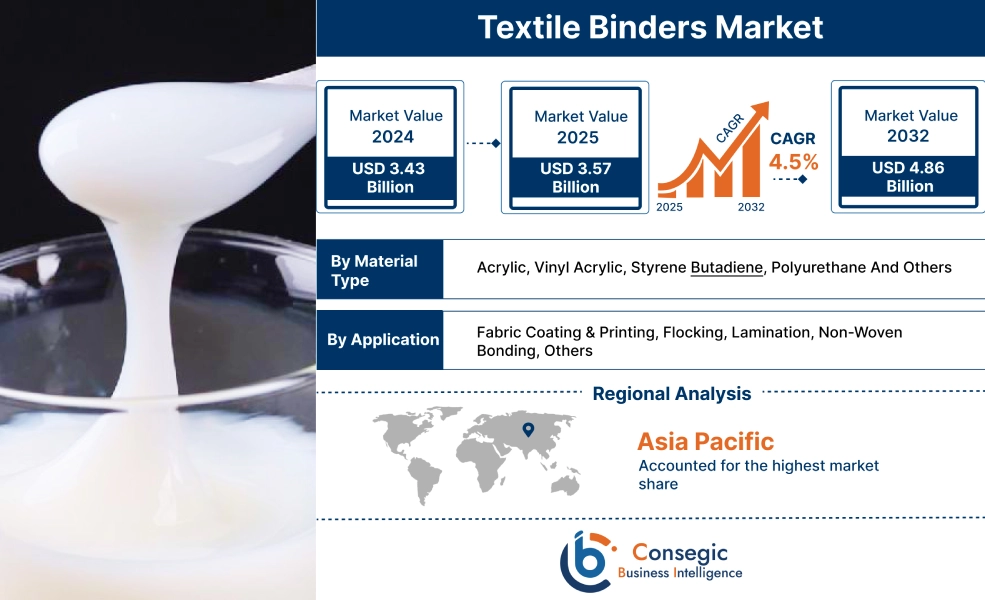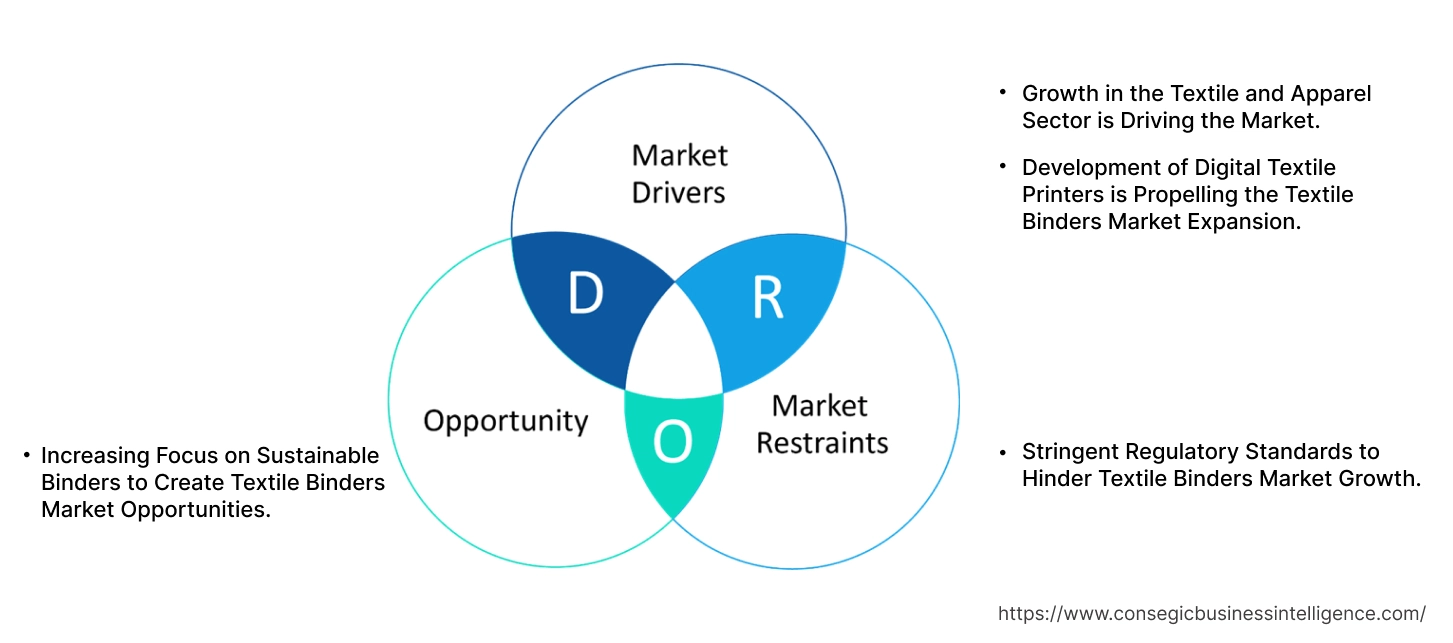Textile Binders Market Size:
The Textile Binders Market size is growing with a CAGR of 4.5% during the forecast period (2025-2032), and the market is projected to be valued at USD 4.86 Billion by 2032 from USD 3.43 Billion in 2024. Additionally, the market value for 2025 is attributed to USD 3.57 Billion.
Textile Binders Market Scope & Overview:
Textile binders are specialized polymeric substances that act as crucial binding agents. They are designed to effectively adhere to various components within a textile structure or to provide desired functional and aesthetic properties to fabrics. These materials are typically applied in liquid emulsion or dispersion forms and play a vital role in processes such as fabric coating & printing, flocking, lamination and the bonding of nonwoven textiles. By creating strong and flexible films, these binders ensure the durability of pigments, enhance colorfastness, improve hand-feel, and contribute significantly to the durability, washability, and overall performance of finished textile products.
How is AI Transforming the Textile Binders Market?
There is a rising adoption of AI in the textile binders market, particularly in chemical formulation, process optimization, quality control, and predictive maintenance. AI-powered systems are used in textile binder manufacturing to enhance several processes, ranging from material selection and design innovation to predictive maintenance, automated quality control, and efficient supply chain management. By analyzing vast datasets, AI-powered systems can predict optimum binder formulations, identify defects in real-time, optimize production workflows, reduce waste, and improve overall product quality and production efficiency. Thus, the above factors are expected to propel the market growth during the forecast period.
Textile Binders Market Dynamics - (DRO) :
Key Drivers:
Growth in the Textile and Apparel Sector is Driving the Market.
The evolving fashion trends and the change in consumer preferences are influencing the surge of apparels and textiles. This increased production volume directly translates into a higher consumption of textile binders as these components are used across numerous stages of textile manufacturing. The rise in textile production, including industrial production, is influencing the use of these binders.
For instance,
- According to IBEF, the textiles and apparel industry is a significant contributor to the country's economy, accounting for 2.3% of its GDP, 13% of industrial production, and 12% of total exports.
Hence, as per the market analysis, due to the aforementioned factors, progress in the textile and apparel sector is driving the growth of the market.
Development of Digital Textile Printers is Propelling the Textile Binders Market Expansion.
The digital printers allow for rapid prototyping, shorter production runs, mass customization, and on-demand printing. This perfectly aligns with fast-changing fashion cycles and personalized consumer demands. This shift requires the development and increased use of specialized textile binders. Digital textile printing inks, especially pigment inks, rely heavily on binders to ensure proper adhesion of colorants to the fabric, achieve vibrant colors, and provide excellent wash fastness and durability without requiring extensive post-treatment steps. Manufacturers are developing new printers that provide exceptional printing qualities.
For instance,
- In 2023, HPRT introduced three novel printers namely DA18FS Hybrid online sizing flatbed screen digital textile printer, DA186T Plus high-speed roll-to-roll dye sublimation digital textile printer, and DA188SL PRO MAX pretreatment inline conveying-belt direct to fabric digital textile Printer. They provide high speed, high definition, high efficiency, and high quality of textile printing outputs
Thus, owing to the afore-mentioned factors, the rise in development of textile printers is accelerating the Textile Binders market expansion.
Key Restraints:
Stringent Regulatory Standards to Hinder Textile Binders Market Growth.
The textile binders sector faces significant hurdles due to stringent regulatory standards imposed by various regulatory bodies worldwide. These regulations, designed to ensure product safety and efficacy, mainly involve rigorous testing, extensive documentation, and lengthy approval processes. Compliance with these standards is time-consuming and costly, particularly for smaller companies or those developing novel binders.
Additionally, changes in regulatory guidelines or the introduction of stricter regulations disrupt established processes and require significant investments in research, development, and manufacturing to meet the new standards. These factors contribute to increased costs, delayed product launches, and limited market access, ultimately hindering market turnover.
Future Opportunities :
Increasing Focus on Sustainable Binders to Create Textile Binders Market Opportunities.
The rise in sustainable factors such as growing environmental regulations that aim to reduce the ecological footprint of the textile sector, growing consumer awareness and preference for eco-friendly and ethically produced textiles, and the commitment of major textile brands towards more sustainable supply chains is influencing the requirement for sustainable binders for textiles. Manufacturers are focusing on binders that are biobased, or water based to adhere to various sustainable factors.
For instance,
- In 2025, Arkema introduced its new range ENCOR bio-based waterborne dispersions designed for textile printing and finishing applications. These binders consist of 30% bio-based content and reduces up to 40% carbon footprint compared to traditional textile resins.
Thus, due to the aforementioned factors, increasing focus on sustainable binders to create textile binders market opportunities.
Textile Binders Market Segmental Analysis :
By Material Type:
Based on material type, the market is categorized into acrylic, vinyl acrylic, styrene butadiene, polyurethane and others
Trends in Material Type:
- The growing trend for pigment printing is influencing the use of acrylic copolymers as a raw material.
- There is a growing demand for bio-based and sustainable materials that are used in the production of binders.
The acrylic binders segment accounted for the largest Textile Binders market share in 2024
- Acrylic binders, particularly acrylic copolymers, hold the largest market share, mainly because their enhanced properties, including excellent adhesion, durability, water and weather resistance, good color retention, and compatibility with a wide range of pigments.
- The primary function of acrylic binders in textiles is to adhere pigments, fibers, or coatings to the fabric substrate, ensuring durability, and overall product integrity.
- They are widely used in pigment printing and various fabric coating applications, which are major segments of the textile sector.
- Manufacturers are developing novel systems for bio-based textile printing.
- Thus, as per the market textile binders market analysis, based on the above-mentioned factors, the acrylic segment dominates the Textile Binders market demand.
The polyurethane binders is expected to grow at the fastest CAGR over the forecast period.
- Polyurethane (PU) offers a unique combination of superior elasticity, abrasion resistance, and durability, making it highly desirable for a wide range of high-performance textile applications.
- PU binders provide excellent adhesion to various substrates, contribute to a soft & flexible hand-feel, and maintain color vibrancy even after repeated washing and wear.
- This versatility, coupled with ongoing innovations in bio-based PU formulations, creates potential for PU based binder.
- Manufacturers are providing novel systems for bio-based textile printing.
- For instance, Covestro introduced INSQIN which is a waterborne PU binders that allows the production of water-based inks for digital application that deliver high durability with a soft handle.
- Thus, as per the market analysis, the growing potential for the use of polyurethane is influencing the growth of the segment.
By Application:
The Application segment is categorized into fabric coating & printing, flocking, lamination, non-woven bonding, others
Trends in the Application
- The growing trend for efficient and durable stay of pigment and fabric coating is influencing the use of binders.
- The rising trend for enhanced structural integrity of textiles is influencing the use of these binders for non-woven bonding.
The fabric coating & printing segment accounted for the largest textile binders market share of 41.02% in 2024.
- In pigment printing, binders form a clear, flexible, three-dimensional polymeric film on the fabric surface that encapsulates the pigment particles and physically adheres them to the fibers during a curing process.
- Additionally, binders are applied to the entire surface of the fabric to provide a range of desired functionalities beyond just color. This includes making fabrics water-resistant, flame-retardant, anti-slip, stiffer, or softer, depending on the specific application.
- Manufacturers are introducing various printing systems that use these binders for enhancing the output of the fabric coating and printing.
- For instance, in 2024, Archroma introduced NTR Printing System to make bio-based pigment printing commercially possible. Archroma’s NTR Printing System is the first to utilize renewable feedstock across pigment dispersion, binder made from various materials and fixing agents.
- Thus, based on the market analysis, as per the aforementioned factors, the fabric coating & printing segment is influencing the Textile Binders market trends.
The non-woven bonding segment is expected to grow at the fastest CAGR over the forecast period.
- Non-woven bonding is a growing application for textile binders, where these polymeric agents play an important role in providing structural integrity, strength, and specific performance characteristics to nonwoven fabrics.
- Unlike woven or knitted textiles, nonwovens are sheet or web structures bonded together by fibers mechanically, thermally, or chemically.
- Textile binders are primarily used in chemical bonding, where a binder in liquid form mainly emulsion or dispersion is applied to a fibrous web.
- Thus, owing to the aforementioned factors, the non-woven bonding segment is expected to show lucrative growth over the forecast period.
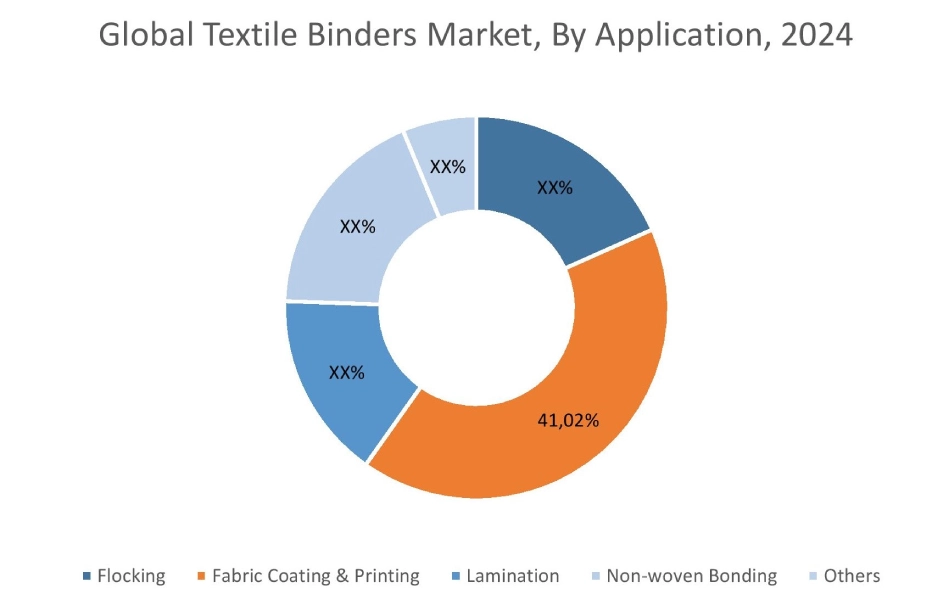
Regional Analysis:
The regional segment includes North America, Europe, Asia Pacific, the Middle East and Africa, and Latin America.
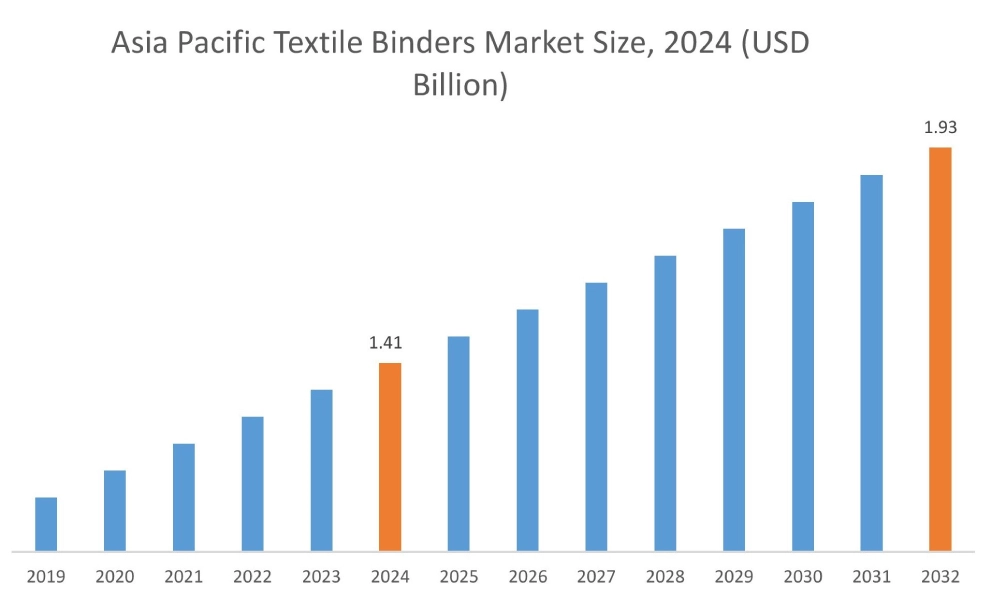
In 2024, Asia Pacific accounted for the highest market share at 41.04% and was valued at USD 1.41 Billion and is expected to reach USD 1.93 Billion in 2032. In Asia Pacific, China accounted for the market share of 39.11% during the base year of 2024. The Asia Pacific region plays a major role in the textile and apparel industry, acting as a dominant manufacturing hub and consumer market. This large expanding scale of textile production directly correlates with a significant rise in the requirement for textile binders. The APAC region is increasingly adopting advanced textile technologies, including digital printing and the production of technical textiles, which require specialized and high-performance binders. The expansion in the production of textiles and apparels in this region is influencing the use of these binders in them.
For instance,
- In 2024, China exported USD 299 Billion of Textiles, being the 2nd most exported product in China. In 2024, the main destinations of China's Textiles exports were United States, Vietnam, Japan, South Korea, and Bangladesh.
Thus, as per the market analysis, the growing production and exports of textiles and apparels are driving the textile binders market trends.
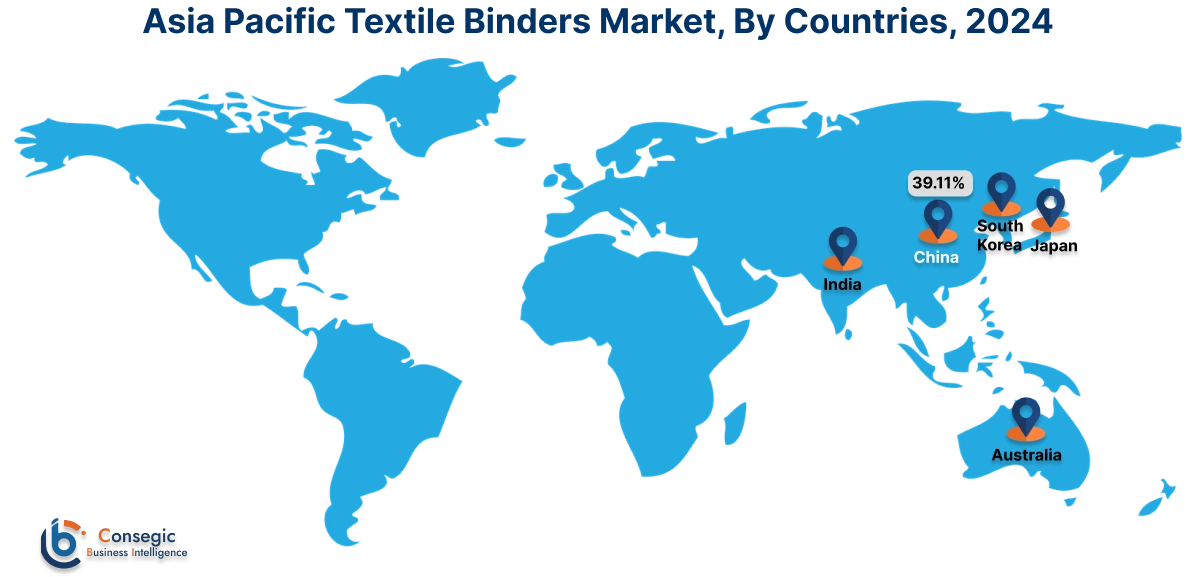
In Europe, the Textile Binders industry is experiencing the fastest growth with a CAGR of 5.5% over the forecast period. The growing focus of manufacturers towards the utilization of sustainable binders that are aligning with the European Unions goals is the key factor contributing to the market demand in this region. Textile Binders contribute to efficient fabric printing and improving the efficiency and lifespan of the textiles. These above-mentioned factors are contributing to the market growth in this region
In North America, polyurethane (PU) binders represent a significant and growing segment within the broader market. Polyurethane binders are synthetic polymeric compounds known for their exceptional versatility, offering a unique combination of flexibility, strength, durability, and resistance to abrasion, chemicals, and UV radiation. These properties make them important for a variety of textile applications, particularly where high performance and longevity are critical, In the North American textile sector, PU binders are extensively utilized for fabric coating and lamination, providing crucial characteristics such as water repellency, breathability, thereby directly having a positive impact on the textile binders market growth.
In the Latin America region, the requirement for textile binders in flocking applications is driven by a dynamic and evolving textile sector. Flocking applies fibers to an adhesive-coated substrate, creating textured surfaces. Textile binders play a crucial role as an adhesive, ensuring a strong, durable bond. Various countries are significant players in the regional textile market, with growing production capacities and increasing focus on diversification and value-added products. Thus, as per the Textile Binders market analysis, the rise in the textile sector and the use of these binders for flocking is contributing to the market trends in the region.
The Middle East and Africa region's expanding textile and apparel sector, coupled with significant investments in infrastructure, fuels the requirement for laminated fabrics in diverse applications mainly for technical textile applications. Textile binders are used in these applications as they provide a strong, durable, and flexible bond that withstands wear, washing, and various environmental conditions Thus, based on the market analysis the use of these binders for laminations further contributing to the Textile Binders market demand in this region.
Top Key Players and Market Share Insights:
The Global Textile Binders Market is highly competitive with major players providing products to the national and international markets. Key players are adopting several strategies in research and development (R&D) and product innovation to hold a strong position in the global Textile Binders market. Key players in the Textile Binders industry include
- ALV Kimya (Turkey)
- Pioneer Chemical Inc (China)
- Arkema (U.S.)
- OMNOVA North America Inc (U.S.)
- Covestro AG (Germany)
- Texochem Industries (India)
- Dow (United States)
- Fineotex Chemical Limited (India)
- Guangdong Yinyang Environment-Friendly New Materials Co., Ltd (China)
- Archroma (Switzerland)
Textile Binders Market Report Insights :
| Report Attributes | Report Details |
| Study Timeline | 2019-2032 |
| Market Size in 2032 | USD 4.86 Billion |
| CAGR (2025-2032) | 4.5% |
| By Material Type |
|
| By Application |
|
| By Region |
|
| Key Players |
|
| North America | U.S. Canada Mexico |
| Europe | U.K. Germany France Spain Italy Russia Benelux Rest of Europe |
| APAC | China South Korea Japan India Australia ASEAN Rest of Asia-Pacific |
| Middle East and Africa | GCC Turkey South Africa Rest of MEA |
| LATAM | Brazil Argentina Chile Rest of LATAM |
| Report Coverage |
|
Key Questions Answered in the Report
How big is the Textile Binders market? +
In 2024, the Textile Binders market is USD 3.43 Billion.
Which is the fastest-growing region in the Textile Binders market? +
Europe is the fastest-growing region in the Textile Binders market.
What specific segmentation details are covered in the Textile Binders market? +
By Material Type, and Application segmentation details are covered in the Textile Binders market.
Who are the major players in the Textile Binders market? +
ALV Kimya (Turkey), Texochem Industries (India), Dow (United States) are some of the major players in the market.
